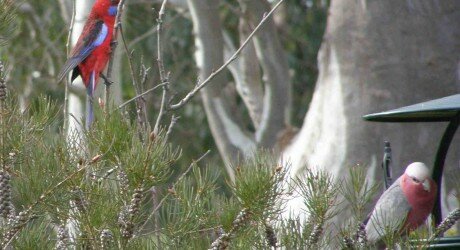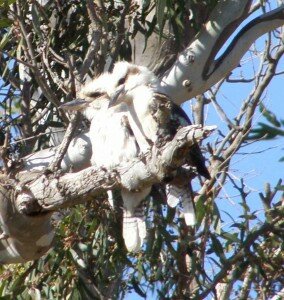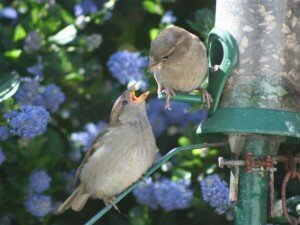Rosella and Galah in a shrubbery at Teesdale
Species extinction and the human record
By Roy Hay
This article was originally published in the Geelong Advertiser, on Tuesday 28 June 2011, p. 16, as ‘For species’ sake, let’s embrace technology.’
My recent column in the Geelong Advertiser (See ‘Limits to Growth,’ 17 June 2011 in Recent articles) on the impact of growing numbers of humans on our environment provoked a constructive response from a reader who pointed to the extinction of many species and the possibility that this will increase in future. Our track record has not been great, though there is another side to that argument which is at least worth canvassing. But we need to go back to the beginning.
There is a strong belief that our Aboriginal ancestors lived in harmony with their environment and set a model that we have not been able to emulate in modern times. However, when the first groups arrived (incidentally as boat people from mainland Asia) when sea levels were much lower than they are now, they were not necessarily at the top of the food chain. Yet eventually the megafauna, the jumbo-sized marsupials and other large carnivorous beasties, disappeared, and human agency and the semi-domesticated dingo are often held responsible. Thereafter, as an often, though not invariably, nomadic set of societies, our original inhabitants realised the value of husbanding their resources, culling by firestick farming, gathering some of the nuts, berries and vegetables, and using technology to create fishtraps and weirs.
The common view is that the Europeans overturned this relationship with the land and natural resources with a rapacious ignorance, from which we have never recovered. As our reader pointed out, many species, which flourished around the time of European settlement and indeed for much later, have subsequently disappeared. On the other hand, people like Thomas Austin are now excoriated for bringing in exotic species, including rabbits and foxes, some of which had a devastating impact on indigenous flora and fauna. To project further decline in species diversity into the future is not the whole story. New species are continually being discovered, sometimes with the use of the most advanced technology, deep in the oceans, for example.
Conservation movements here and abroad have done a great deal to identify and protect species threatened with extinction, using the best available technology to trace, count and observe the features of their existence and habitat which are necessary for their survival. Some examples have been so successful that they had to be scaled back because they upset the local environment. The repopulation of Tower Hill, near Warrnambool, with koalas is one such case. So trial and error is involved and we still have vast gulfs of ignorance to cross, but it should not all be gloom and doom.
Further down the track the work that has been done on analyzing DNA and the building blocks of life, like the human genome project, raise the possibility of bringing back extinct species. It is easy to say that is just science fiction and that cloning and the other methods currently available raise serious ethical problems. I agree, but it would be wrong to rule out the possibility of finding ways of recreating life forms which are acceptable in future.
A recent article on crowdsourcing, the idea of offering rewards via the internet for the best ideas that can be worked up into viable projects, has also produced some important advances in the arena of conservation. Instead of relying on a small group of experts within an organisation, the problem is thrown open to the best minds around the world. Their responses are then workshopped with people who have relevant production and commercial experience to produce new solutions. In the relevant case, Sony and the World Wildlife Fund asked ‘How can technology help us make the most of the planet’s resources?’ Nearly 400 ideas were generated and the winner was an interactive online magazine which linked people with local projects. OpenIDEO.com is at the hub of many more such ideas and it was co-founded by a Melbourne designer, Haiyan Zhang.
So it is more than possible that technology may come to our aid in dealing with the risks of species extinction. Meanwhile, there is an existing matter which can be solved or at least ameliorated, thanks to Thomas Austin. If sparrows are disappearing in the United Kingdom today, we could re-export the squadrons in our shrubberies in Teesdale to repopulate their original homeland.










Marnie Haig-Muir: Your review of the latest Rankin is right on the money, Roy. This book...